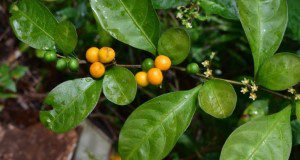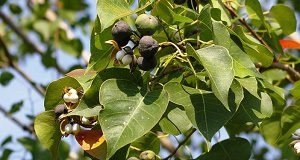Two-leaf nightshade, Solanum diphyllum, is a member of the Solanaceae or potato family. It is native to Mexico southwards to Costa Rica. It has escaped cultivation in Florida and grows as far north as Duval County and from Volusia County south to Miami-Dade County. A “bird-dispersed” volunteer, it occurs in urban and conservation areas and on disturbed land. The plants produce abundant berries with many many small seeds. This new 5-page publication of the UF/IFAS Environmental Horticulture Department is primarily intended for Florida gardeners, landscapers, and land managers, and it contains information on identification, flowering, fruiting, and management recommendations for this widely occurring plant. Written by Stephen H. Brown, Chris Marble, and Stephen F. Enloe.
https://edis.ifas.ufl.edu/ep588
Tag: Invasive Weeds
Controlling Invasive Exotic Plants in North Florida Forests
Of the more than 4,000 known plant species growing in Florida, approximately 30% are not native to Florida or the Southeast, and in the US invasive exotic species cost an estimated $120 billion each year in damages. Early detection and removal of invasive plants is the key to successful management. This publication describes many of the current methods used in north Florida forest operations to manage invasive exotic plants. It also provides references for additional sources of information. Written by Chris Demers, Patrick Minogue, Michael Andreu, Alan Long, and Rick Williams.
http://edis.ifas.ufl.edu/fr133
Waterhyacinth: Florida's Worst Floating Weed
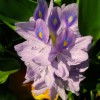 Waterhyacinth is one of the world’s worst aquatic weeds and is Florida’s most intensively managed floating plant. Dense mats formed by this species interfere with human uses of water bodies and disrupt ecosystems by preventing penetration of light and oxygen into the water column. This attractive, free-floating aquatic plant grows throughout the year in southern Florida but often dies back during the winter in the northern parts of the state. Waterhyacinth is cultivated as a water garden and pond plant, but cultivation, sale, and possession of this noxious weed is prohibited in Florida. This 5-page fact sheet was written by Lyn A. Gettys, and published by the UF Department of Agronomy, September 2014.
Waterhyacinth is one of the world’s worst aquatic weeds and is Florida’s most intensively managed floating plant. Dense mats formed by this species interfere with human uses of water bodies and disrupt ecosystems by preventing penetration of light and oxygen into the water column. This attractive, free-floating aquatic plant grows throughout the year in southern Florida but often dies back during the winter in the northern parts of the state. Waterhyacinth is cultivated as a water garden and pond plant, but cultivation, sale, and possession of this noxious weed is prohibited in Florida. This 5-page fact sheet was written by Lyn A. Gettys, and published by the UF Department of Agronomy, September 2014.
http://edis.ifas.ufl.edu/ag385
Rotala: A New Canal Invader in Southern Florida
 Rotala is a relative newcomer to Florida. Since it was first found in Coral Springs in 1996, it has established large, but mostly isolated, populations throughout the southern regions of Florida. It is especially problematic in Lee and Collier Counties and along the west coast. Extremely dense submersed populations and large thick mats dominate the surface of the water, greatly reducing ecosystem services, because oxygen level and light penetration are hampered. Because the rapid and vigorous growth of rotala inhibits water flow, the ability of infested canals to function properly in flood control systems is greatly hindered. Management of this aquatic weed is a major concern for resource managers. This 4-page fact sheet was written by Lyn A. Gettys and Carl J. Della Torre II, and published by the UF Department of Agronomy, April 2014.
Rotala is a relative newcomer to Florida. Since it was first found in Coral Springs in 1996, it has established large, but mostly isolated, populations throughout the southern regions of Florida. It is especially problematic in Lee and Collier Counties and along the west coast. Extremely dense submersed populations and large thick mats dominate the surface of the water, greatly reducing ecosystem services, because oxygen level and light penetration are hampered. Because the rapid and vigorous growth of rotala inhibits water flow, the ability of infested canals to function properly in flood control systems is greatly hindered. Management of this aquatic weed is a major concern for resource managers. This 4-page fact sheet was written by Lyn A. Gettys and Carl J. Della Torre II, and published by the UF Department of Agronomy, April 2014.
http://edis.ifas.ufl.edu/ag381
Managing Mexican Petunia (Ruellia simplex C. Wright) in the Home Landscape
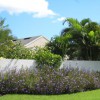 Environmental tolerance, abundant seed production, and an ability to easily grow from plant stem sections have allowed Mexican petunia to spread into natural areas that border urban areas. The Florida Exotic Pest Plant Council lists Mexican petunia (wild-type and non-sterile cultivars) as a Category 1 invasive species, meaning that it is “altering native plant communities by displacing native species, changing community structures or ecological functions, or hybridizing with natives”. These potential changes to community structure and ecological function are of particular concern in Florida wetlands, where changes to plant communities have the potential to impact not just plant-animal interactions, but also overall hydrology on a whole watershed level. This 6-page fact sheet was written by C. A. Reinhardt Adams, C. Wiese, L.C. Lee, S.B. Wilson, A. M. Smith, and R. Freyre, and published by the UF Department of Environmental Horticulture, April 2014.
Environmental tolerance, abundant seed production, and an ability to easily grow from plant stem sections have allowed Mexican petunia to spread into natural areas that border urban areas. The Florida Exotic Pest Plant Council lists Mexican petunia (wild-type and non-sterile cultivars) as a Category 1 invasive species, meaning that it is “altering native plant communities by displacing native species, changing community structures or ecological functions, or hybridizing with natives”. These potential changes to community structure and ecological function are of particular concern in Florida wetlands, where changes to plant communities have the potential to impact not just plant-animal interactions, but also overall hydrology on a whole watershed level. This 6-page fact sheet was written by C. A. Reinhardt Adams, C. Wiese, L.C. Lee, S.B. Wilson, A. M. Smith, and R. Freyre, and published by the UF Department of Environmental Horticulture, April 2014.
http://edis.ifas.ufl.edu/ep498
The UF/IFAS Assessment of Nonnative Plants in Florida’s Natural Areas: History, Purpose, and Use
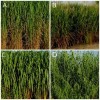 Nonnative invasive plant species pose a significant threat to Florida’s natural areas. The UF/IFAS Assessment of Nonnative Plants in Florida’s Natural Areas (hereafter, UF/IFAS Assessment) uses literature-based risk assessment tools to predict the invasion risk of both nonnative species that occur in the state as well as species proposed for introduction. The UF/IFAS Assessment team has evaluated more than 770 species, including 97 species proposed for introduction or new uses. The team is actively identifying and evaluating potentially problematic nonnative species (and sub-specific or hybrid taxa). Recommendations and supporting information from the UF/IFAS Assessment can be found at http://plants.ifas.ufl.edu/assessment. This 6-page fact sheet was written by Deah Lieurance, S. Luke Flory, Aimee L. Cooper, Doria R. Gordon, Alison M. Fox, Joan Dusky, and Linda Tyson, and published by the UF Department of Agronomy, November 2013.
Nonnative invasive plant species pose a significant threat to Florida’s natural areas. The UF/IFAS Assessment of Nonnative Plants in Florida’s Natural Areas (hereafter, UF/IFAS Assessment) uses literature-based risk assessment tools to predict the invasion risk of both nonnative species that occur in the state as well as species proposed for introduction. The UF/IFAS Assessment team has evaluated more than 770 species, including 97 species proposed for introduction or new uses. The team is actively identifying and evaluating potentially problematic nonnative species (and sub-specific or hybrid taxa). Recommendations and supporting information from the UF/IFAS Assessment can be found at http://plants.ifas.ufl.edu/assessment. This 6-page fact sheet was written by Deah Lieurance, S. Luke Flory, Aimee L. Cooper, Doria R. Gordon, Alison M. Fox, Joan Dusky, and Linda Tyson, and published by the UF Department of Agronomy, November 2013.
http://edis.ifas.ufl.edu/ag376
Wildland Weeds: Paragrass, Urochloa mutica (SSAGR370/AG375)
 Paragrass (also referred to as Californiagrass) is thought to have been introduced into Florida sometime in the late 1870s as a forage plant. The semiaquatic grass is a native of tropical Africa, and today it is established in both hemispheres in tropical and subtropical regions as a highly palatable fodder. The grass is established in regions of poorly drained soils and along freshwater shorelines in Alabama, Florida, Hawaii, Maryland, Oregon, South Carolina, and Texas. It is an extremely aggressive competitor that can displace many shoreline emergent plants and plants in cultivated or disturbed sites associated with moist soil. Paragrass becomes readily established in wet soils along shorelines where it can form large monocultures. This 4-page fact sheet was written by L. T. Markle, B. A. Sellers, and W. A. Overholt, and published by the UF Department of Agronomy, April 2013.
Paragrass (also referred to as Californiagrass) is thought to have been introduced into Florida sometime in the late 1870s as a forage plant. The semiaquatic grass is a native of tropical Africa, and today it is established in both hemispheres in tropical and subtropical regions as a highly palatable fodder. The grass is established in regions of poorly drained soils and along freshwater shorelines in Alabama, Florida, Hawaii, Maryland, Oregon, South Carolina, and Texas. It is an extremely aggressive competitor that can displace many shoreline emergent plants and plants in cultivated or disturbed sites associated with moist soil. Paragrass becomes readily established in wet soils along shorelines where it can form large monocultures. This 4-page fact sheet was written by L. T. Markle, B. A. Sellers, and W. A. Overholt, and published by the UF Department of Agronomy, April 2013.
http://edis.ifas.ufl.edu/ag375
Controlling Invasive Exotic Plants in North Florida Forests (SSFOR19/FR133)
 Invasive non-native organisms are one of the greatest threats to the natural ecosystems of the United States. Invasive plants reduce biodiversity, encroach on endangered and threatened species, and rob native species of habitat. This 8-page fact sheet describes many of the current methods used to manage some of the more common and troublesome invasive exotic plants in north Florida forests. Written by Chris Demers, Alan Long and Rick Williams, and published by the UF Department of School of Forest Resources and Conservation, January 2012.
Invasive non-native organisms are one of the greatest threats to the natural ecosystems of the United States. Invasive plants reduce biodiversity, encroach on endangered and threatened species, and rob native species of habitat. This 8-page fact sheet describes many of the current methods used to manage some of the more common and troublesome invasive exotic plants in north Florida forests. Written by Chris Demers, Alan Long and Rick Williams, and published by the UF Department of School of Forest Resources and Conservation, January 2012.
http://edis.ifas.ufl.edu/fr133
Phragmites in Florida (ENY860/IN898)
 Phragmites are a tall, perennial, wetland grasses, occurring in both fresh and brackish waters. This 3-page fact sheet discusses the three genetic lineages, native, Gulf Coast, and Eurasian; and the threat posed to Florida ecosystems by an invasion of the exotic Eurasian type. Written by W. A. Overholt, R. Diaz, M. Hanson and D. Williams, and published by the UF Department of Entomology and Nematology, December 2011.
Phragmites are a tall, perennial, wetland grasses, occurring in both fresh and brackish waters. This 3-page fact sheet discusses the three genetic lineages, native, Gulf Coast, and Eurasian; and the threat posed to Florida ecosystems by an invasion of the exotic Eurasian type. Written by W. A. Overholt, R. Diaz, M. Hanson and D. Williams, and published by the UF Department of Entomology and Nematology, December 2011.
http://edis.ifas.ufl.edu/in898
Identification, Impacts, and Control of Ragweed Parthenium (Parthenium hysterophorus L.) (ENH1187/EP448)
 One of the worlds most invasive weeds, this member of the Asteraceae family is a problem in Africa, Australia, India, and is increasingly a problem in Florida. Learn more in this 10-page fact sheet was written by Robert H. Stamps, and published by the UF Department of Environmental Horticulture, December 2011.
One of the worlds most invasive weeds, this member of the Asteraceae family is a problem in Africa, Australia, India, and is increasingly a problem in Florida. Learn more in this 10-page fact sheet was written by Robert H. Stamps, and published by the UF Department of Environmental Horticulture, December 2011.
http://edis.ifas.ufl.edu/ep448
Wright’s Nutrush: An Invader of Seasonal Wetlands in Florida (SSAGR342/AG352)
 This non-native sedge has been increasing in Florida wetlands. This 9-page fact sheet describes its distribution, history and impacts, ecological overview, integrated management and identification. Written by Colette C. Jacono, Kenneth A. Langeland, and Jeffrey Hutchinson, and published by the UF Department of Agronomy, November 2011.
This non-native sedge has been increasing in Florida wetlands. This 9-page fact sheet describes its distribution, history and impacts, ecological overview, integrated management and identification. Written by Colette C. Jacono, Kenneth A. Langeland, and Jeffrey Hutchinson, and published by the UF Department of Agronomy, November 2011.
http://edis.ifas.ufl.edu/ag352
Wright’s Nutrush: An Invader of Seasonal Wetlands in Florida (SSAGR342/AG352)
Wright’s nutrush (Scleria lacustris) is a non-native sedge that has been increasing in Florida wetlands. This 9-page fact sheet describes its distribution, history and impacts, ecological overview, integrated management and identification. Written by Colette C. Jacono and Kenneth A. Langeland, and published by the UF Department of Agronomy, April 2011.
http://edis.ifas.ufl.edu/ag352
Control y Biología del Helecho Trepador Japonés (Lygodium japonicum) (FOR282/FR344)
This 7-page Spanish-language fact sheet describes this non-native, invasive vine which is widespread in damp areas in north and West Florida — its biology and control measures. Written by Patrick J. Minogue, Daniela Chevasco, Francisco Escobedo, and Kimberly K. Bohn, and published by the UF Department of School of Forest Resources and Conservation, December 2010.
http://edis.ifas.ufl.edu/fr344
SSAGR328/AG338 Mile-a-minute (Mikania micrantha): A New Weed in South Florida
SSAGR328, a 2-page illustrated fact sheet by Brent Sellers and Ken Langeland, describes this new weed, a highly branched perennial vine, reported in late 2009 near Homestead FL, and how to identify it and what to do if you find it. Published by the UF Department of Agronomy, January 2010.
http://edis.ifas.ufl.edu/ag338
FOR218/FR280 Biology and Control of Japanese Climbing Fern (Lygodium japonicum)
FOR-218, a 7-page illustrated fact sheet by Patrick J. Minogue, Stella Jones, Kimberly K. Bohn, and Rick L. Williams, describes this non-native, invasive vine which is widespread in damp areas in north and West Florida — its biology and control measures. Includes references. Published by the UF School of Forest Resources and Conservation, May 2009.
http://edis.ifas.ufl.edu/FR280
SS-AGR-312/AG318 Natural Area Weeds: Invasive Solanum spp. in Florida
SS-AGR-312, a 7-page illustrated fact sheet by L. T. Markle, W. A. Overholt and K. A. Langeland, provides a guide to differentiate the invasive Solanum species, information about the ecology and management of each species, and information on Solanum capsicoides All., which can easily be confused with some of the invasive Solanum species. Includes references. Published by the UF Department of Agronomy, December 2008.
http://edis.ifas.ufl.edu/AG318
SS-FOR19/FR133 Controlling Invasive Exotic Plants in North Florida Forests
Revised! SS-FOR-19, an 8-page fact sheet by Chris Demers, Alan Long and Rick Williams, describes many of the current methods being used to manage some of the more common and troublesome invasive exotic plants in north Florida forests. Includes tables of herbicide recommendations and references. Published by the UF School of Forest Resources and Conservation, June 2008.
http://edis.ifas.ufl.edu/FR133
SSAGR307/AG313 Biology and Control of Indian Jujube (Ziziphus mauritiana): A Weed to Watch in Florida Pastures and Natural Areas
SS-AGR-307, a 3-page illustrated fact sheet by Brent Sellers, describes this large shrub native to southern Asia and eastern Africa, and which is reported in Miami-Dade, Lee, and Glades counties — it’s identification, habitat and ecology, spread, and conrol. Includes references. Published by the UF Department of Agronomy, August 2008.
http://edis.ifas.ufl.edu/AG313
